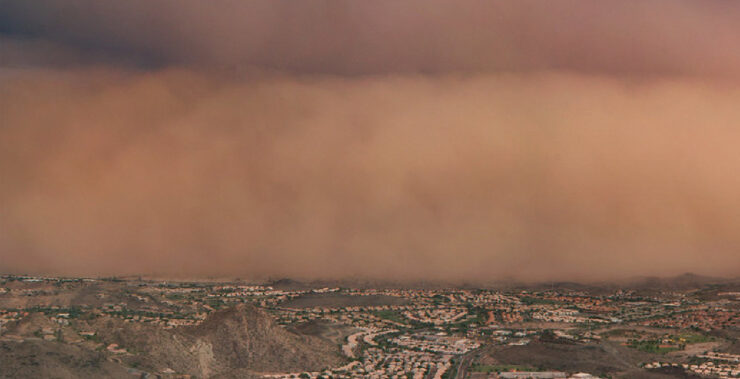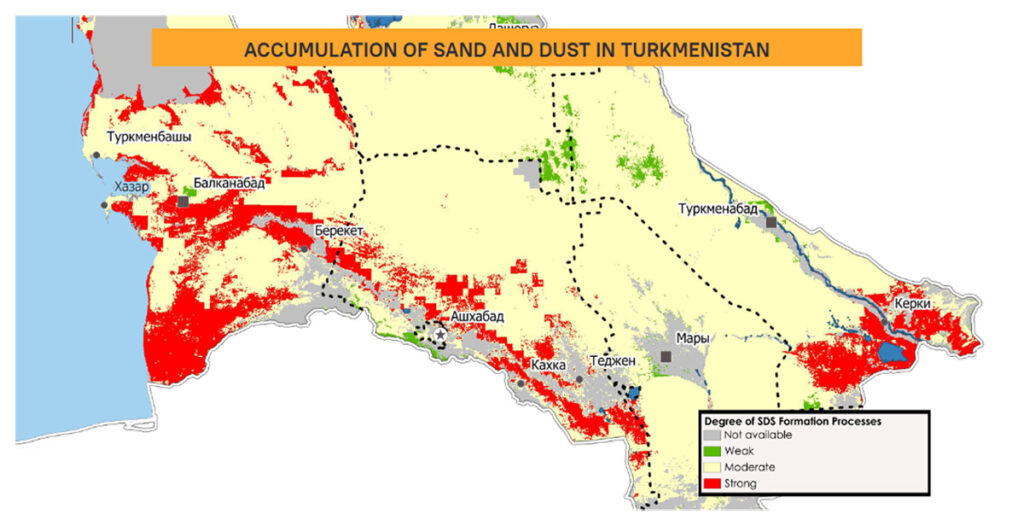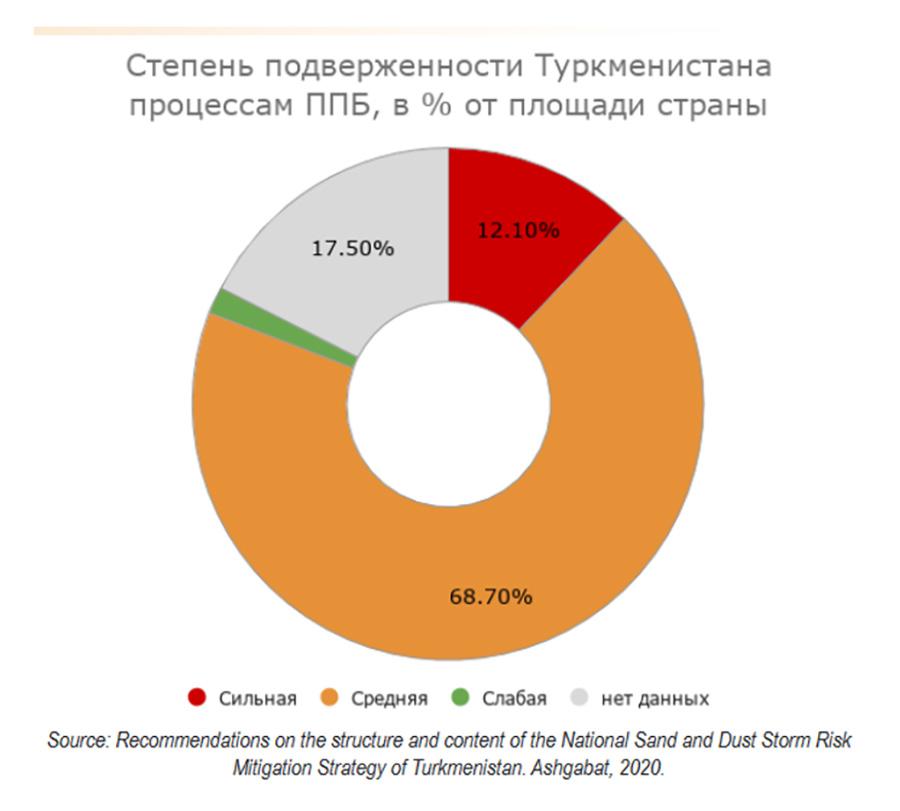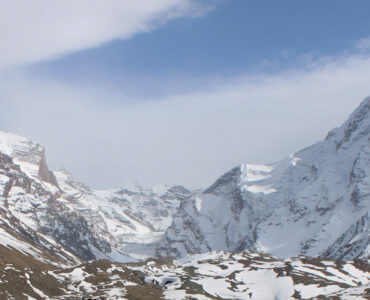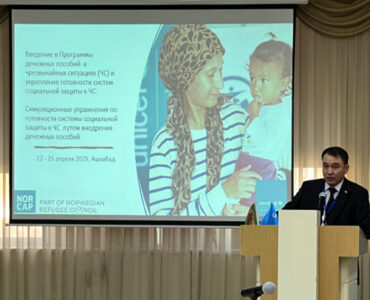Central Asia is a home for several major sand and dust sources, among that is the Karakum Desert which makes up approximately 80% of the area of Turkmenistan. Low annual precipitation level coupled with predominantly flat terrain provides favorable conditions for the generation of sand and dust storms (SDS). As a result of climate change and desertification processes, the frequency and severity of these events are growing and are expected to be further exacerbated (World Bank, 2021) in the future.
It is estimated that more than 80% of the population of Turkmenistan (United Nations, 2021) is exposed to medium and high levels of poor air quality because of SDS. Agriculture is also strongly affected, as research shows that more than 70% of the agricultural area in Turkmenistan is exposed to dust deposition, characterized by high salt content, resulting in significant reduction in cotton production. The independent media has highlighted the increased frequency of sand and dust storms in Turkmenistan, with reported SDS events between November 2023 and February 2024.
Source: The National Sand and Dust Storm Risk Mitigation Strategy of Turkmenistan
What are sand and dust storms? What are their impacts?
Sand and dust storms are natural phenomena that are often seasonal and concentrated in certain regions of the world, and are exacerbated by land degradation, droughts, and climate change. Every year 2 billion tons of dust are estimated to be emitted into the atmosphere. The UN General Assembly adopted a resolution on SDS, titled “Combating sand and dust storms” in 2015, which states that SDS pose a significant challenge to sustainable development, and measures need to be taken to address them.
The world’s major dust sources are located in the “dust belt” (North Africa, the Middle East, and East Asia) and to a lesser extent in the southern hemisphere (Australia, South America, Southern Africa). Although Central Asia is not the largest dust source, there are major SDS sources such as the Karakum Desert, northern lowlands of the Caspian Sea, and the Kyzylkum Desert. With recent human-induced activities, some other large sources of SDS have sprung up, such as the Aral Sea.
Impacts of these events are often overlooked as SDS do not usually result in immediate extensive damage, but their impact is often indirect and accumulates over time, as noted by the UNCCD (2022). The main impacts are damaged crops, stripped soils, and livestock damage. SDS can also impact far-away areas over thousands of kilometers. In deposition areas, where sand and dust are transported, SDS can adversely impact human health, causing allergies and respiratory diseases, and disrupt economic activity. Although there are no comprehensive global studies on the economic impact of SDS, available research already indicates that SDS cause significant economic losses. For example, one estimate showed that the impact of SDS on oil and gas operations in Kuwait in 2018 alone cost 9.36 million USD (UNCCD, 2022).
Increased frequency of sand and dust storms in Turkmenistan
According to the reports by Azatlyk Radiosy, Lebap region has repeatedly seen sandstorms from October last year until now, caused by strong winds. November 2023 has been especially rich in SDS events, with storms detected on at least 23 days of the month. In December, sandstorms were detected on at least 15 days of the month. Majority of these storms took place in the Mary, Lebap, and Ahal regions. However, SDS have not stopped there, with at least 6 articles dedicated to sandstorms published on Meteostorm since the beginning of the year.
The observed frequency of sandstorms in only 2 months (November and December) is worrying, especially considering that the previous research in 2005 has shown that the highest mean annual frequency of dust storm days recorded has been 62 days in the east and 67 days in the west of Central Karakum Desert. Additionally, the same research has shown for the Central Karakum Desert that sandstorms happen more frequently in spring than winter.
While these weather events have a significant impact on the health of the exposed population, government-controlled media remains silent. The media does not inform the population about sand and dust storms, their impacts, or measures to be taken. The impacts, however, are seen not only by residents, but are also noticed by air traffic, with planes having difficulties landing at the Turkmenabat airport.
Measures taken in Turkmenistan
According to a briefly mentioned information in the Nationally Determined Contribution of Turkmenistan under the Paris Agreement, sandstorms occur on 35-67 days a year, with higher occurrence rates of 106-113 on some years. While the government does not yet otherwise publicly acknowledge the problem and is yet to educate the public, a few steps in the right direction have been made. A project launched in 2020 by the United Nations Convention to Combat Desertification (UNCCD) aims to prepare country-level strategies to combat sand and dust storms and droughts in Central Asia.
Donate to support Turkmen analysts, researchers and writers to produce factual, constructive and progressive content in their efforts to educate the public of Turkmenistan.
SUPPORT OUR WORKAs part of the project, recommendations on the structure and content of the National Sand and Dust Storm Risk Mitigation Strategy of Turkmenistan have been published in 2021, and strategic conclusions document where explanations on SDS, their sources in Turkmenistan, and their impacts for health and agriculture are explained.
The summary of government’s report (which is not available in full) highlights the following:
- The total economic impact of desertification in Turkmenistan (including the cost of reforestation and fixing of dynamic sands) is estimated at $346.9 million annually. In 2017, the share of agriculture in Turkmenistan’s GDP was more than 10%, or 14.7 billion manats. With the gross value of agricultural production in 2017 at 20.4 billion manat, the loss of even 15% of the value of agricultural production would be more than 3 billion manat, or $873.9 millions.
- Turkmenistan reportedly cooperates with a number of international organizations to combat desertification and has already implemented several projects. Among these are the planting of 35 million trees in order to protect cities from sand and dust, more forest plantation in the Botendag area, refilling of the artificial lake ‘Altyn Asyr’ to allow watering of 11 million hectares of desert pastures, and others. An action plan to build institutional capacity to effectively manage SDS in the country is reportedly in the full report. However, as of February 17, 2024, only 4 other Central Asian countries have published their national plans, but only recommendations on the content and structure of the national plan have been published for Turkmenistan, dated from 2020.
- Southern and Western parts of Central Asia, in particular Turkmenistan, are more prone to droughts. Drought probability is estimated to be more than 50% in around 55% of the area of Turkmenistan, an area of 26.5 million ha, a share higher than in any other Central Asian country. In 22.8% of the country, drought probability is estimated to be 40-50%, while 10.1% of the area has a 30-40% probability of droughts.
Source: The National Sand and Dust Storm Risk Mitigation Strategy of Turkmenistan
Recommendations and guidelines by UNCCD
As the National Action Plan for Management and Mitigation of SDS for Turkmenistan is not yet available, Turkmenistan can make use of other available research on the topic, such as a report by the UNCCD on SDS, published in May 2022 and titled “Sand and dust storms compendium: Information and guidance on assessing and addressing the risks”. The Compendium provides detailed overview on sand and dust storms, associated risks, and guidelines on how these risks and impacts can be assessed and mitigated.
The Compendium can serve as a detailed guideline for governments and policymakers on how to formulate a SDS policy and prepare plans for mitigating the impacts of SDS, collect the data, assess the risks, develop monitoring systems, population warnings, and others.
Challenges associated with SDS
The report by UNCCD identifies several challenges when addressing the negative impacts of SDS.
- Effective management of SDS requires addressing a wide range of individual negative impacts caused by SDS instead of addressing a single SDS impact.
- Impacts of SDS are cross-sectoral and trans-national, requiring wide cooperation between various stakeholders outside of their regular scope of activity.
- A wide range of involved stakeholders requires efficient access to information.
- Impacts of SDS are often isolated in time and space, which makes them less noticeable compared to other natural disasters.
The UNCCD report suggests to prioritize the following action areas:
- Monitoring, prediction, and early warning of SDS.
- Impact mitigation, vulnerability, and resilience, to reduce the direct effects of SDS.
- Source mitigation, to reduce the potential harm from SDS.
The report has detailed step-by-step guidelines for the SDS-related risk assessment and also provides guidelines on estimating the damages and costs of SDS. It highlights the need to calculate the impacts on all affected sectors: transport, health, household cleaning, commerce, manufacturing, and agriculture. Additionally, the report provides an overview of models used for forecasting SDS.

